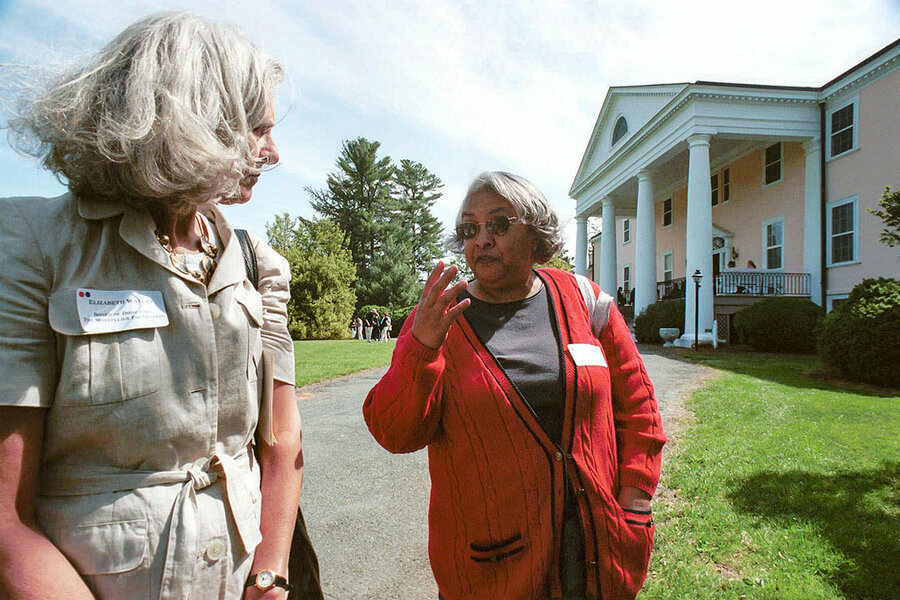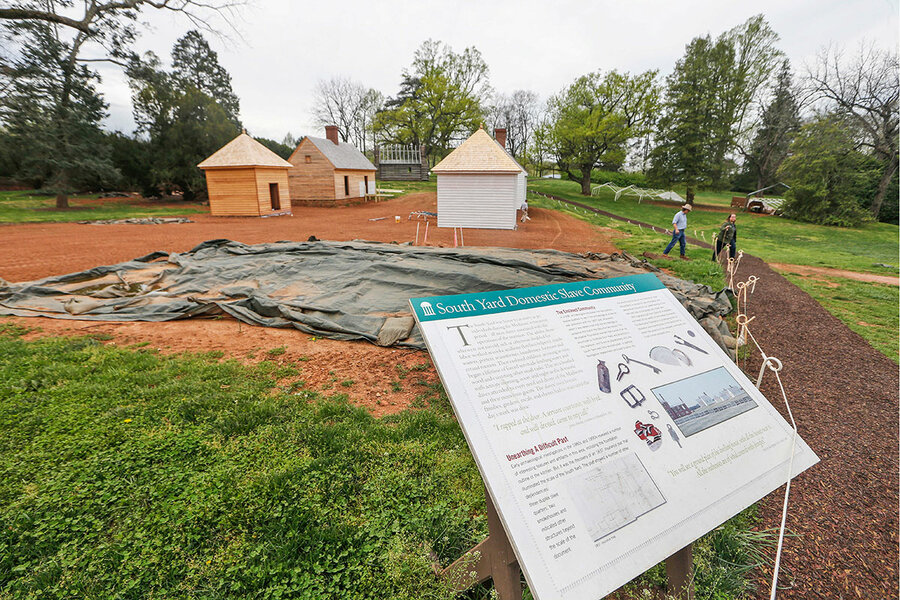Presidential plantation shifts telling of history to let all voices rise
Loading...
| Orange, Va.
Montpelier, Founding Father James Madison’s former home and tobacco plantation, is breaking new ground as the nation’s first museum of its kind that’s governed by descendants of the people once enslaved there.
It’s also breaking ground, literally, in the search for evidence of the community where the enslaved people lived and worked. The goal is to move away from tours focused on the manor house and to treat the history of Montpelier’s enslaved people as a responsibility equal to the history of Montpelier’s owners.
Why We Wrote This
A story focused onHow do you tell history responsibly? Montpelier, the plantation owned by President James Madison, is expanding its focus to give more equal voice to the experience of workers once enslaved there – and to their descendants.
But first that history has to be found.
The staff has mapped out a giant grid and is surveying each square with metal detectors. They look for nails, coins, bullets, and other artifacts. A tobacco drying house would only need nails to support the wood and hooks to hang the leaves. So a plot of land filled with nails and hooks would probably be one of those. A home would have other items – like ceramics, animal bones, buttons, and bricks.
“If you tell a wider, more inclusive, and more accurate story, you invite more people to identify themselves with this important history,” says James French, a descendant of someone enslaved there and member of the board. “That’s a uniting force.”
The forest around Montpelier, James Madison’s former home and tobacco plantation, has miles of paved trails. But Larry Walker isn’t using them. Instead, he has strapped on a rucksack, laced up boots, and tucked his pants into his socks. No asphalt today – he’s ready for a walk in the woods.
For miles, he and a group of colleagues travel what feels like the opening scene in “Raiders of the Lost Ark,” adapted to Virginia history. They walk in a line, carrying sticks at eye level to catch cobwebs. Out front, Matthew Reeves, Montpelier’s director of archaeology and landscape restoration, clears a path with a machete. He even wears a fedora.
Mr. Walker and James French, another foundation board member on the mid-August hike, are descendants of the more than 300 people once enslaved at Montpelier. The two men are scouting a permanent trail in the east woods, leading past former irrigation ditches, tobacco fields, and slave quarters. It’s part of a museumwide reimagining of Montpelier’s mandate, led by the nation’s first museum of its kind governed by descendants.
Why We Wrote This
A story focused onHow do you tell history responsibly? Montpelier, the plantation owned by President James Madison, is expanding its focus to give more equal voice to the experience of workers once enslaved there – and to their descendants.
This odyssey, over decades, has at times deeply tested relationships. Earlier this year, Montpelier’s governing board fought publicly over who should tell Madison’s story – part of it as Founding Father of the United States, part as an enslaver. But that fight has ended, and the museum is trying to expand Montpelier’s narrative of history. That effort has led staff beyond the big house and toward the backwoods, where artifacts of enslaved people sit undisturbed.
“For me to center the voice of my ancestor doesn’t diminish the voice of anyone else’s ancestor,” says Mr. Walker. “If anything, it amplifies.”
The rocky road toward parity
Montpelier’s staff has worked with local descendants for decades. But in 2018, the museum hosted a summit on the topic, which helped create what’s called “the rubric,” a set of standards to help sites represent descendants of enslaved people. In 2021, Montpelier made national news when the board voted to create “structural parity” with the Montpelier Descendants Committee (MDC), which was formed in 2019. For the first time at any U.S. presidential site, these descendants would equally govern the place their ancestors lived.
The agreement never took effect. Within months, members of the MDC said, the existing board was imposing conditions on their autonomy, representation, and ability to speak freely. The relationship collapsed. In March, the board voted to change its bylaws, reversing the parity decision.
“I felt a lot of grief,” says Mr. French, attending the meeting over Zoom. “But I was also sitting in the house that was built by my three-times great-grandfather who was enslaved on that very property. As always, in difficult moments, I was inspired by what they went through.”
Within days, however, the National Trust for Historic Preservation, which owns Montpelier, condemned the vote. The MDC hired a lawyer and pleaded its case in the media. Multiple board members told the Monitor that certain donors threatened to withhold gifts.
By May, several board members who had voted to revoke the MDC’s authority resigned. The Montpelier Foundation elected new members and named Mr. French chairperson. A large majority currently supports the MDC, and, going forward, the plan is for the bylaws to again guarantee parity. In the meantime, the staff’s work with descendants has resumed.
Moving beyond the manor house
Even before its latest work, Montpelier had already established multiple spaces that teach about slavery. In the cellar of the manor house, “The Mere Distinction of Colour” exhibit emphasizes enslavement’s human impact. Just west of the house, visitors can enter reconstructed slave quarters that include life-size images of descendants and recorded stories of their ancestors. Museum tours teach about slavery and include specific stories of enslaved people.
That effort has mattered to visitors.
Steve Hanna, a cultural geographer at the University of Mary Washington in Fredericksburg, Virginia, studies how presidential sites present Black history. At Montpelier, according to his research, visitors reported learning more about and feeling more empathy for enslaved people than at similar sites. The data has some bias: Visitors self-select into most exhibits, and the people who visit presidential sites tend to be white, as well as older, more educated, and more affluent than the average American. Before the pandemic, Montpelier had around 125,000 visitors per year. Half of those polled by Professor Hanna spent time at an exhibit related to slavery.
“It made them feel like they learned more about enslavement and were able to empathize with people who suffered, survived, and endured being enslaved,” he says.
But as is often the case at presidential sites, the visitor experience still orbits Montpelier’s big house. That’s not necessarily a problem, says Elizabeth Chew, Montpelier’s acting CEO; it’s just incomplete. Much of the site’s history is farther away and far less excavated. Unearthing it is now one of their top priorities. Parity isn’t just about equal representation for descendants, says Dr. Chew. It’s also about giving the stories of their ancestors equal weight.
Montpelier spans more than 2,600 acres and was even bigger when the Madisons were alive. Dolley Madison sold the estate in 1844, and no owner has farmed extensively there since. For the staff, that’s a powerful resource. “The ground is pristine,” says Dr. Chew. “That’s where a lot of the evidence of the lives of the enslaved lives.”
Finding the fields in the forest
Dr. Reeves and other staff members are now trying to make that evidence more accessible. It’s just hard to blaze a trail when the important sites are now covered in trees.
To discover what’s there, the staff has to search for whatever time can’t erase. Slave quarters, sheds, kitchens – none of the original structures in the fields were built to last. Still, certain pieces of them are just beneath the surface.
So the staff has mapped the entire east woods into a giant grid and is surveying each square with metal detectors. They look for nails, coins, bullets, and other artifacts, recording what they find and where they found it. The more finds in an area, the more likely that area once contained something important.
“Archaeology is in large part the study of trash,” says Dr. Chew.
A tobacco drying house would only need nails to support the wood and hooks to hang the leaves. So a plot of land filled with nails and hooks would probably be one of those. A home would have other items – like ceramics, animal bones, buttons, and bricks.
Meanwhile, all of this work can connect to Montpelier’s two fundamental missions: telling the history of Madison and the history of the enslaved people there. “Madison in essence lived in an African American community,” says Mr. French. “He was influenced as much by them as they were by him.”
“A uniting force”
In August, Susan Lange, from Annapolis, Maryland, stopped by Montpelier with her husband while in town for a wedding. Standing in the sun, wearing a hat and bright sundress decorated with palm trees, she wished her tour had lasted longer and included places like the nearby slave quarters. “It just really stood out … showing that each person was more than their enslavement, that they were a fiddle player or a mother,” she says. “Those feel like obvious statements, but [it emphasized] the humanity.”
Mr. French hopes more visitors leave with an experience like hers. There’s already been a backlash to the new board, evident in recent critical articles and online reviews describing the tour as “woke,” imbalanced, and having an “obsession about slavery.” Each of the four board members interviewed by the Monitor mentioned it. They also noted that none of the exhibits have changed; only the board has.
Standing by the decaying witness tree, sweating in his ball cap, his pants tucked into his socks, Mr. French says he hopes the site can matter to others the way it does to him. “There’s a thirst to know what is my past,” he says.
This is the place he can quench it, and to Mr. French, Madison’s home is exactly the kind of place America needs today. Montpelier nurtured James Madison, the champion of American Federalism and the Bill of Rights. He helped guarantee Americans’ individual liberties; he and his family also enslaved hundreds of people, a third of whom were children, over more than a century.
“If you tell a wider, more inclusive, and more accurate story, you invite more people to identify themselves with this important history,” he says. “That’s a uniting force.”










